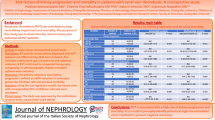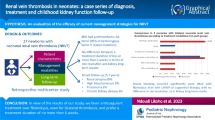Abstract
Background
Renal vein thrombosis (RVT) is a rare event with myriad clinical manifestations. Published experience regarding the clinical course and management of RVT in patients beyond the neonatal period is limited to case reports and small case series.
Methods
A multicenter retrospective review of consecutive admitted patients with diagnosed RVT between January 2000 and May 2015 at three different university hospitals.
Results
Thirty-nine patients (53.8 % men and 46.2 % women) were included. Median age was 58 years. Malignancy (n = 19, 48.7 %), nephrotic syndrome (n = 8, 20.5 %) and infection (n = 5, 12.8 %), were the most common underlying conditions. Compared to non-cancer patients, patients with active cancer tended to be significantly older (mean age 63 ± 18 vs. 37 ± 22 years, P = 0.001) and presented with non-acute symptoms (P = 0.01) and unrevealing physical findings (P = 0.02). Thrombosis extension beyond the renal vein occurred in 69.2 % of cases and was more common in cancer patients (P = 0.001). Anticoagulation therapy was administered in 71.8 % of patients leading to resolution of thrombus in most cases (30/32 patients, 94 %) during follow-up evaluation. There were six recurrent thrombotic events during a mean follow-up of 35 ± 43 months. Nine patients (28 %) died during follow-up, all of them with malignancy.
Conclusion
Active cancer is the most common cause of RVT and should be excluded when RVT is diagnosed. Clinical course of RVT in cancer patients is more indolent and diagnosis requires high index of suspicion. Survival rates are governed by the presence of malignancy.

Similar content being viewed by others
References
Rayer P. Traité des maladies des reins et des altérations de la sécrétion urinaire. Paris: J.-B. Baillière; 1841. p. 1839–40.
Witz M, Korzets Z. Renal vein occlusion: diagnosis and treatment. Isr Med Assoc J. 2007;9:402–5.
Kosch A, Kuwertz-Broking E, Heller C, Kurnik K, Schobess R, Nowak-Gottl U. Renal venous thrombosis in neonates: prothrombotic risk factors and long-term follow-up. Blood. 2004;104:1356–60.
Asghar M, Ahmed K, Shah SS, Siddique MK, Dasgupta P, Khan MS. Renal vein thrombosis. Eur J Vasc Endovasc Surg. 2007;34:217–23.
Wysokinski WE, Gosk-Bierska I, Greene EL, Grill D, Wiste H, McBane RD, et al. Clinical characteristics and long-term follow-up of patients with renal vein thrombosis. Am J Kidney Dis. 2008;51:224–32.
Lionaki S, Derebail VK, Hogan SL, Barbour S, Lee T, Hladunewich M, et al. Venous thromboembolism in patients with membranous nephropathy. Clin J Am Soc Nephrol. 2012;7:43–51.
Radhakrishnan J. Venous thromboembolism and membranous nephropathy: so what’s new? Clin J Am Soc Nephrol. 2012;7:3–4.
Singhal R, Brimble KS. Thromboembolic complications in the nephrotic syndrome: pathophysiology and clinical management. Thromb Res. 2006;118:397–407.
Brandao LR, Simpson EA, Lau KK. Neonatal renal vein thrombosis. Semin Fetal Neonatal Med. 2011;16:323–8.
Llach F, Papper S, Massry SG. The clinical spectrum of renal vein thrombosis: acute and chronic. Am J Med. 1980;69:819–27.
Wei LQ, Rong ZK, Gui L, Shan RD. CT diagnosis of renal vein thrombosis in nephrotic syndrome. J Comput Assist Tomogr. 1991;15:454–7.
Gatewood OM, Fishman EK, Burrow CR, Walker WG, Goldman SM, Siegelman SS. Renal vein thrombosis in patients with nephrotic syndrome: CT diagnosis. Radiology. 1986;159:117–22.
Ogunbiyi OA. Renal vein thrombosis in patients with nephrotic syndrome: CT diagnosis. Afr J Med Med Sci. 1995;24:33–40.
Tait C, Baglin T, Watson H, Laffan M, Makris M, Perry D, et al. Guidelines on the investigation and management of venous thrombosis at unusual sites. Br J Haematol. 2012;159:28–38.
Kuhle S, Massicotte P, Chan A, Mitchell L. A case series of 72 neonates with renal vein thrombosis. Data from the 1–800-NO-CLOTS Registry. Thromb Haemost. 2004;92:729–33.
Kowal J, Figur A, Hitzig WM. Renal vein thrombosis and the nephrotic syndrome with complete remission. J Mt Sinai Hosp N Y. 1963;30:47–58.
Author information
Authors and Affiliations
Corresponding author
Ethics declarations
Conflict of interest
The authors declare that they have no conflict of interest.
About this article
Cite this article
Rottenstreich, A., Barzilai, M., Da’as, N. et al. Active malignancy in patients with renal vein thrombosis: influence upon clinical course and survival. Clin Exp Nephrol 21, 49–54 (2017). https://doi.org/10.1007/s10157-016-1245-0
Received:
Accepted:
Published:
Issue Date:
DOI: https://doi.org/10.1007/s10157-016-1245-0




